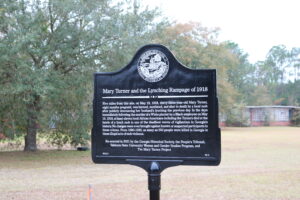December 13, 2021, Savannah, Georgia – The Georgia Historical Society (GHS) has announced the unveiling and rededication of a replacement Civil Rights Trail historical marker in Lowndes County recognizing Mary Turner and the Lynching Rampage of 1918. The Marker was re-erected by GHS, The People’s Tribunal, Valdosta State University Woman and Gender Studies Program, and the Mary Turner Project.
Speakers for the dedication included Dr. Michael G. Noll, Professor of Geography at Valdosta State University and the Valdosta Coalition for Peace and Justice; Councilman Mason Barfield, Mayor Pro Tem of Hahira; Dr. Thomas Aiello, Professor of History at Valdosta State; Bob Elder for The People’s Tribunal; Pastor Michael Bryant, Webb Miller Community Church; Audrey Grant, Randy McClain, and Katrina Thomas, representing the descendants of Mary Turner; and Elyse Butler, Historical Marker Manager at the Georgia Historical Society.
“Like other historical markers across the state, the Mary Turner and the Lynching Rampage of 1918 historical marker creates a space where we can remember and discuss. We can stand on the ground where history happened and have a connection to the past,” said Elyse Butler.
Originally dedicated in 2010 at the site where the lynching took place, the marker was repeatedly vandalized, including being shot several times by gunfire. In 2020, vandals attempted to break the post, leaving large cracks in the marker base. The replacement marker is located five miles from the original site at Webb Miller Community Church, where it will be more readily and safely accessible to the public and help to better tell the story of Mary Turner and the events of 1918. The church is located at 300 Blakely Street in Hahira, Georgia.
“Coming to terms with your past is painful, but every society must eventually embrace the uncomfortable facets of its history. Without truth, there can be no forgiveness, no reconciliation, no healing, and no justice,” said Dr. Michael Noll. “This historical marker will facilitate conversations we have avoided for far too long, but conversations we must have to begin a healing process and to prevent racial injustices in our future."
The Georgia Civil Rights Trail Initiative was established in 2015 as part of the ongoing work of the Georgia Historical Society's Marker Program to recognize the rich diversity of our state’s past and focuses broadly on the economic, social, political, and cultural history of the Civil Rights Movement.
For further information about the Mary Turner and the Lynching Rampage of 1918 historical marker or the Georgia Civil Rights Trail Marker Program, please contact Patricia Meagher, GHS Director of Communications at 912.651.2125, ext. 153 or by email at pmeagher@georgiahistory.com.
The marker reads as follows:
Mary Turner and the Lynching Rampage of 1918
Five miles from this site on May 19, 1918, thirty-three-year-old Mary Turner, eight months pregnant, was burned, mutilated, and shot to death by a local mob after publicly denouncing her husband’s lynching the previous day. In the days immediately following the murder of a White planter by a Black employee on May 16, 1918, at least eleven local African Americans including the Turners died at the hands of a lynch mob in one of the deadliest waves of vigilantism in Georgia’s history. No charges were ever brought against known or suspected participants in these crimes. From 1880-1930, as many as 550 people were killed in Georgia in these illegal acts of mob violence.
Erected by the Georgia Historical Society, the People’s Temple, Valdosta State University – Woman and Gender Studies Program, and The Mary Turner Project
###
ABOUT THE GEORGIA HISTORICAL SOCIETY
Georgia Historical Society (GHS) is the premier independent statewide institution responsible for collecting, examining, and teaching Georgia history. GHS houses the oldest and most distinguished collection of materials related exclusively to Georgia history in the nation.
To learn more visit georgiahistory.com.
ABOUT THE GEORGIA HISTORICAL MARKER PROGRAM
The Georgia Historical Society (GHS) administers Georgia’s historical marker program. Over the past 20 years, GHS has erected nearly 300 new historical markers across the state on a wide variety of subjects. GHS also coordinates the maintenance for more than 2,100 markers installed by the State of Georgia prior to 1998. Online mapping tools allow users to design driving routes based on historical markers, and a mobile app helps visitors locate and learn about markers nearby. Visit georgiahistory.com for more ways to use Georgia’s historical markers and experience history where it happened..

